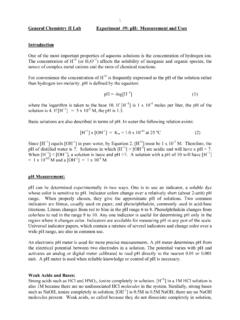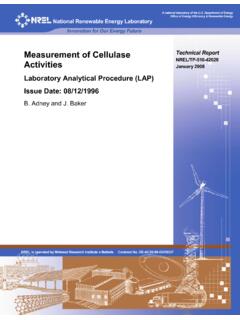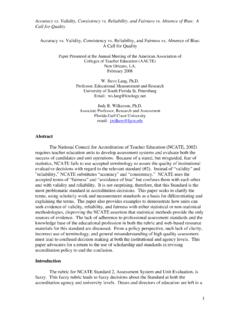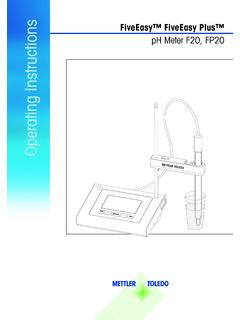Transcription of Manual: Theory and Practice of pH Measurement
1 Theory and Practice of pH MeasurementPN 44-6033/rev. DDecember 2010 Theory AND Practice OF pH MEASUREMENTTABLE OF CONTENTSTHEORY AND PRACTICEOF pH MEASUREMENTTABLE OF CONTENTSS ection .. Definition of Measurements in Industry .. FOR MEASURING .. Electrode .. Junction Junction Reference THE pH Measurement .. Voltage to Electrode Slope .. and Using Temperature , Insulation, and LIMITATIONS .. Potential Mismatch .. ORP Measurements .. THE SENSOR .. and Insertion Applications .. Connections .. pH pH pH .. with Calibrations .. Loops ..29iTHEORY AND Practice OF pH MEASUREMENTTABLE OF CONTENTSTHEORY AND PRACTICEOF pH MEASUREMENTLIST OF APPENDICESS ection TitlePageASilver/Silver Chloride Electrode OF FIGURESF igure # TitlePage1-1 Operational Definition of pH Measurement Cell ..42-2 Measuring Cross-Section through the pH Glass ..52-4 Reference Electrode ..62-5 The Origin of Liquid Junction Potentials ..72-6 Comparison of Large Pore and Small Pore Liquid Junctions.
2 72-7 Junction Plugging Caused by Silver Double Junction Reference Electrode ..83-1 Glass Electrode Slope ..103-2 Two-Point Buffer Calibration ..113-3 Isopotential Liquid Junction Potential Sodium Oxidation-Reduction Potential ..175-2 ORP Measurement Cell ..185-3 Measuring ORP Measurement Interpretation ..196-1 pH Sensor Installation in Flow-Through Checking the Potential of the Reference Electrode ..24A-1 Silver/Silver Chloride Electrode ..30B-1 Cell Voltage as a Function of OF TABLEST able No. TitlePage3-1 NIST Standard Buffers ..117-1 Cleaning Procedures ..238-1 RTD Resistance Values ..278-2 Input Signals for Simulated Buffer Calibration .. OVERVIEWThe determination of pH is one of the most common process chemical measurements made today. This bookletexplains the principles behind the Measurement and discusses ways of avoiding common pitfalls. The booklet alsodiscusses industrial ORP (oxidation-reduction potential) measurements.
3 Although the determination of ORP is notnearly as common as pH, certain industries make valuable use of the INTRODUCTIONpH is a measure of the relative amount of hydrogen and hydroxide ions in an aqueous solution. In any collectionof water molecules a very small number will have dissociated to form hydrogen (H+) and hydroxide (OH-) ions:H2O = H++ OH-The number of ions formed is small. At 25 C fewer than 2 x 10-7% of the water molecules have dissociated. Interms of molar concentrations, water at 25 C contains 1 x10-7moles per liter of hydrogen ions and the same con-centration of hydroxide any aqueous solution, the concentration of hydrogen ions multiplied by the concentration of hydroxide ions isconstant. Stated in equation form: Kw= [H+] [OH-](1)where the brackets signify molar concentrations and Kwis the dissociation constant for water. The value of Kwdepends on temperature. For example, at 25 C Kw= x 10-14and at 35 C Kw= x 10-14. Acids and bases, when dissolved in water, simply alter the relative amounts of H+and OH-in solution.
4 Acidsincrease the hydrogen ion concentration, and, because the product [H+] [OH-] must remain constant, acidsdecrease the hydroxide ion concentration. Bases have the opposite effect. They increase hydroxide ion concen-tration and decrease hydrogen ion concentration. For example, suppose an acid is added to water at 25 C and theacid raises the H+concentration to x 10-4moles/liter. Because [H+] [OH-] must always equal x 10-14,[OH-] will be x 10-10 is another way of expressing the hydrogen ion concentration. pH is defined as follows:pH = -log [H+](2)Therefore, if the hydrogen ion concentration is x 10-4moles/liter, the pH is The term neutral is often used in discussions about acids, bases, and pH. A neutral solution is one in which thehydrogen ion concentration exactly equals the hydroxide ion concentration. At 25 C, a neutral solution has At 35 C, a neutral solution has pH The common assertion that neutral solutions have pH 7 is not statement is true only if the temperature is 25 AND Practice OF pH MEASUREMENTSECTION OPERATIONAL DEFINITION OF pH MEASUREMENTS IN OPERATIONAL DEFINITION OF pHAlthough equation 2 is often given as the definition of pH, it is not a good one.
5 No one determines pH by first meas-uring the hydrogen ion concentration and then calculating pH. pH is best defined by describing how it is 1-1 illustrates the operational definition of pH. The starting point is an electrochemical cell. The cell consistsof an indicating electrode whose potential is directly proportional to pH, a reference electrode whose potential isindependent of pH, and the liquid to be measured. The overall voltage of the cell depends on the pH of the sam-ple. Because different indicating electrodes have slightly different responses to pH, the measuring system must becalibrated before use. The second step in the operational definition of pH is calibration. The system is calibratedby placing the electrodes in solutions of known pH and measuring the voltage of the cell. Cell voltage is a linearfunction of pH, so only two calibration points are needed. The final step in the operational definition is to place theelectrodes in the sample, measure the voltage, and determine the pH from the calibration is apparent that the practical determination of pH requires standard solutions of known pH.
6 The standard solu-tions are called buffers, and the pH values assigned to them define the pH scale. The procedure by which pH val-ues are assigned to buffers is beyond the scope of this discussion. There is one important point, pH values requires making assumptions concerning the chemical and physical properties of elec-trolyte solutions. Slightly different assumptions lead to slightly different pH values for the same solution. Therefore,slightly different pH scales can , it should be noted that equation 2 is somewhat misleading. The equation implies that pH is a measure ofconcentration. In fact, pH is really a measure of ion activity. Concentration and activity are not the same, but theyare related. See Section and the Glossary for more AND Practice OF pH MEASUREMENTSECTION 1-1. Operational Definition of figure shows the three steps in the determination of pH. The three steps constitute the operational definition of pH MEASUREMENTS IN INDUSTRYA lthough pH is a measure of hydrogen ion activity, the fact is of little interest to anyone but a physical chemist.
7 Itis certainly of scant importance in industrial pH measurements. The major use of pH in industry is process pH helps ensure product quality, reduces corrosion and scaling in plant equipment, and protects theenvironment by helping wastewater dischargers meet regulatory limits. Process pH control limits are often empirical. It is less important to know why a given pH range works than to keepthe pH in the desired range. It is, therefore, important that the person making and using pH measurements under-stand how the Measurement is made, how to calibrate the measuring instrument, and how to recognize and avoidcommon booklet has five major sections. The first section discusses the construction and features of the electro-chemical cell used for measuring pH. The second section discusses how the pH analyzer converts the measuredcell voltage into pH. The third section discusses some fundamental limitations to pH measurements. The fourthsection discusses industrial ORP measurements.
8 Because ORP Measurement cells have much in common withpH cells, much of the information in the pH cell section applies to ORP measurements. The fifth section deals withinstallation, maintenance, and troubleshooting of pH AND Practice OF pH MEASUREMENTSECTION GENERALIn nearly every industrial and scientific application, pH is determined by measuring the voltage of an electrochem-ical cell. Figure 2-1 shows a simplified diagram of a pH cell. The cell consists of a measuring electrode, a refer-ence electrode, a temperature sensing element, and the liquid being measured. The voltage of the cell is directlyproportional to the pH of the liquid. The pH meter measures the voltage and uses a temperature-dependent fac-tor to convert the voltage to pH. Because the cell has high internal resistance, the pH meter must have a very highinput 2-1 shows separate measuring and reference electrodes. In most process sensors, the electrodes and thetemperature element are combined into a single body.
9 Such sensors are often called combination cell voltage is the algebraic sum of the potentials of the measuring electrode, the reference electrode, and theliquid junction. The potential of the measuring electrode depends only on the pH of the solution. The potential of thereference electrode is unaffected by pH, so it provides a stable reference voltage. The liquid junction potentialdepends in a complex way on the identity and concentration of the ions in the sample. It is always present, but if thesensor is properly designed, the liquid junction potential is usually small and relatively constant. All three potentialsdepend on temperature. The construction of the electrodes and the electrical potentials associated with them are discussed in Sections AND Practice OF pH MEASUREMENTSECTION FOR MEASURING pHSECTION CELLS FOR MEASURING MEASURING REFERENCE LIQUID JUNCTION DOUBLE JUNCTION REFERENCE ELECTRODESFIGURE 2-1. pH Measurement Cell.
10 The cell consists of a measuring and reference electrode. The voltage between the electrodes is directly proportional to thepH of the test solution. The proportionality constant depends on temperature, so a temperature sensor is also necessary. A100 platinum RTD is commonly used, although 1000 platinum RTDs, 3 k Balco RTDs, and thermistors are also MEASURING ELECTRODEF igure 2-2 shows the internals of the measuring electrode. The heart of the electrode is a thin piece of pH-sensi-tive glass, which is blown onto the end of a length of glass tubing. The pH-sensitive glass, usually called a glassmembrane, gives the electrode its common name: glass electrode. Sealed inside the electrode is a solution ofpotassium chloride buffered at pH 7. A piece of silver wire plated with silver chloride contacts the solution. The silver wire-silver chloride combination in contact with the filling solution constitutes an internal reference elec-trode. Its potential depends solely on the chloride concentration in the filling solution.















